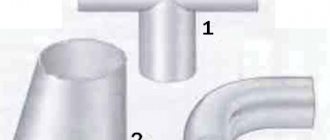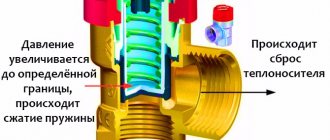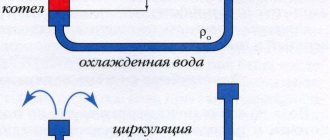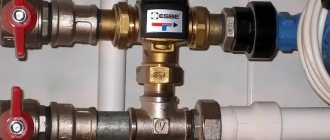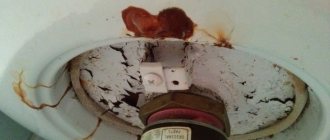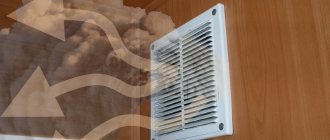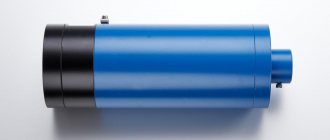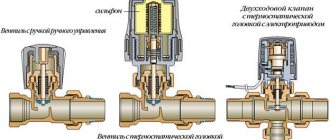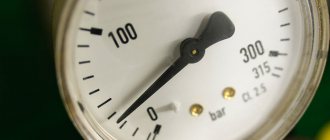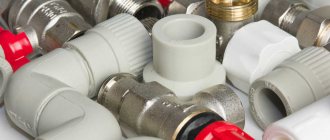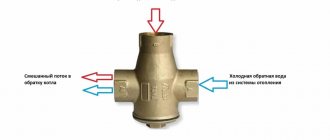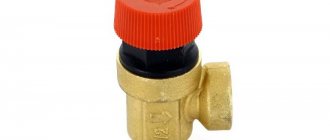Water pressure
2 comments on the entry What is a check valve for a pumping station - how to choose how much it costs
One of the most important elements of an autonomous water supply system is a non-return valve.
Thanks to him, a constant pressure level is maintained in the water supply system, water leakage from the system and pump stop is excluded.
Some models of pumping stations are equipped with a built-in check valve, but for most of them, additional equipment with this element is required.
Check valve purpose ^
The purpose of the check valve is to allow the flow of water to the pump and prevent it from returning. Valves of this type are direct operated devices.
This means that no external control or power source is required for its operation. The check valve opens and closes under the influence of the movement of fluid flow through it.
When the pump is running, the valve opens and passes water through the pipeline, and if the unit is turned off, it closes and does not let it flow in the opposite direction.
In this case, the pressure in the line before the check valve drops to zero, and after it it remains.
We also recommend that you familiarize yourself with the article of the pressure switch of the pumping station, it is necessary to automatically turn on and off the pump, working in tandem with a hydraulic accumulator, it maintains excess pressure in the network, compensates for hydraulic shocks.
Another interesting article about the principles of operation of domestic pumping stations is here, it contains prices, reviews, characteristics and advice on choosing such stations.
Design features and purpose
To understand how important a check valve for water for a pump performs, it is enough to understand the principle of operation of an autonomous water supply system in general and this part of its equipment in particular. The main element of such systems, which carries the main load, is the pumping station. Its functions include pumping out water from an underground source - a well or a well. The water pumped out of a well or well is fed through special pipes to a hydraulic accumulator, which simultaneously performs two functions:
- acts as a storage tank for water;
- allows you to maintain the required water pressure in an autonomous system.
Meanwhile, maintaining the required pressure level in the pipeline will not work if the water coming from an underground source is not blocked in the system. There is no problem with this when the pump is running. When it is off, water can simply flow out of the pipes and the accumulator back into the well or well. In order to prevent this, such a simple, but at the same time effective device, as a water check valve for a pump, is used.
A non-return valve for equipping the pump blocks the backflow of water from the system. The main structural elements of such a device are the housing in which the spring-loaded locking element is located. Thus, the principle of operation of such a shutter is as follows.
- When a flow of water with a certain pressure enters the check valve, the spring is compressed, opening the shut-off element and allowing the liquid to flow freely through the device.
- When the pressure of the water flow in the pipeline drops, the spring of the water check valve returns its closing element to the closed state, thereby blocking the liquid from moving in the opposite direction.
With a check valve, which allows you to quickly block water in the pipeline, the unified water supply system is divided into separate sections, each of which is characterized by its own pressure level of the liquid in the pipes.
Due to their high efficiency, check valves are equally successfully used to equip both domestic borehole pumps and industrial pumping stations. Such devices, in addition, make it possible to reduce damage from a breakdown of the pipeline system in the event that leaks of transported water have formed in its individual sections.
In many cases, the use of check valves is envisaged already at the design stage of autonomous water supply systems. In particular, many models of submersible pumps used for a well or well are equipped with not even one, but several valves during the production process.
Classification ^
There are two types of check valves, which differ in the design of the overlapping element:
- valves - they look like a spool, are used in horizontal sections of pipelines;
- gates - are produced in the form of round discs, they can be mounted both on the horizontal and on the vertical section of the pipeline.
According to the design of the locking element, check valves are divided into several groups:
- lift-type valves: the shutter (locking element) in them is spring-loaded, can only move up or down.
- ball valves: the role of the shut-off element in this design is a ball made of polymer or cast iron.
- swing check valves: the shut-off element is in the form of a flap. It is fixed on an axis located outside the flow area.
- Flanged valves are large and heavy. Cast iron and steel are used for their manufacture. These are the most expensive products in the swing check valve group.
- Wafer valves are cheaper, but they "sin" with higher head losses compared to flanged ones.
- The cheapest rotary check valves are coupling valves.
- Disc check valves: A disc is used as a shut-off element, located perpendicular to the flow axis.
Under the influence of the water flow pressure at the supply, the spring is compressed - and the valve opens. As soon as the water flow decreases, the spring returns the valve to the closed position.
Lift check valves are impressive in size; they are rarely used in the water supply system. Their main area of application is boiler houses and heat supply systems of industrial enterprises;
There are also rubber balls. The closure of the device is carried out only under the influence of gravity: springs are not used in ball valves.
Ball valves are most often used in sewerage systems, but they have proven to be excellent in plumbing as well.
Structures of this kind have low hydraulic resistance. But, due to their size and weight, ball check valves are much more expensive than other types;
This valve design it is mainly used on pipelines with a diameter of more than 50 mm.
By the type of connection, rotary valves are divided into flanged, coupling and wafer type.
This category of valves is also made of cast iron and steel, and series made of anti-corrosion steel are also produced.
Brass and cast iron are used for their production. The head loss on the sleeve valves is less than on the flanged and wafer type.
It moves along the axis of the water supply system. Basically, butterfly valves are made in a sleeve design for pipelines of small diameters, but wafer-type ones can also be found.
The shut-off disc is most often spring-loaded, therefore, the disc valve is unpretentious in installation. It also wins in price, but its head losses are high.Nevertheless, such valves are widely used in utility systems.
Valve classification
The equipment differs in design, material, size. Each has its own characteristics during installation.
By design features, the devices are as follows:
- With a lifting type locking element. The valve is equipped with an up or down shutter blocking the water flow. When liquid enters, the shut-off part goes up and lets it through. When the pressure drops, the shutter is directed downward and blocks the return flow of the water jet. The movement of the mechanism takes place with the help of a spring.
- With a ball valve. Under the pressure, the ball moves and water flows through the system. After the pressure has dropped, the shut-off element returns to its place.
- With disc-shaped constipation. The disc blocks the return flow thanks to the spring device.
- With two shutter valves. They fold under pressure, and when the pressure decreases, they return back.
In everyday life, equipment with a lifting type mechanism is most often used. It can be easily repaired by replacing the spring.
The fixtures are made from a variety of materials. Brass elements do not corrode, are easy to maintain, and can be installed on all types of pipes. Cast iron blocking devices are not used very often. This material rusts, deposits settle on it rather quickly. These valves are only suitable for wide lines.
Stainless steel cases are the most reliable, but also the most expensive. Steel valves do not rust and are not affected by aggressive media, and deposits do not accumulate inside them.
Most of the elements are mounted using a sleeve connection. To do this, you need two threaded adapters, selected according to the section of the pipeline system. Bolted flange connections can also be used. This type of fastening is used for small devices when there is not enough space on the pipes for other fastening. They are usually equipped with valves made of large section cast iron.
The combination of these parameters, as well as the brand, determines the price of the product. The average cost is 700 rubles.
Operating principle ^
At rest, that is, in the absence of water flow, the check valve locking element is in the "closed" position (lies in the seat of the body) either under its own weight or under the influence of a spring.
Under the influence of the pressure of the water flow, it rises and frees the passage through the valve. As soon as the head is zero, the valve is lowered into the seat, thereby preventing the flow back from flowing.
In other words, the check valve is automatically controlled by the medium itself and does not require any additional controls.
Where can a protective device be installed?
Stop valves of this type are widely used. In private households, these are usually submersible pumps or pumping stations for wells or wells. But in addition to such equipment, check valves are used to prevent the outflow of water from the boiler. The part is installed at the outlet of a cold pipeline in the absence of liquid. In addition, the protective device can be mounted on various types of pipelines, especially when using hot and cold pipelines at the same time. Due to the fact that the pressure in the pipes is different, it is possible to push hot water into the pipe with cold water through the mixer. If a valve is installed on each pipeline, then the backflow of liquid will not be possible.
Shut-off valves are widely used in heating systems when the structure consists of several circuits with different coolant pressures. In this case, a pump is installed on each circuit.It may happen that when installing a more powerful pump, it is possible to push the coolant into an adjacent circuit with less powerful equipment. This situation is unacceptable, therefore, the installation of a valve is mandatory in such a heating system. Often, a check valve is installed in the sewer to prevent backflow of waste water.
Check valve installation rules ^
There are two options for installing a check valve on the water supply system, if a pumping station is involved in it:
- in front of the pumping station;
- immediately after the ratchet on the suction pipe.
The second option is considered the most optimal., because the installation of a check valve in front of the station may result in limited water volumerequired for discharge into the suction pipe and subsequent capture by the pump at the moment it is turned on.
Another disadvantage of this arrangement of the check valve is the filling of the suction pipe with air after the water is drained.
In this case, together with the working medium, the pump can capture a portion of air. This leads to the appearance of noise in the pipeline and the expulsion of the airlock when the water tap is opened.
The order and nuances of installation
Before installing the shut-off element after the pump, it should be borne in mind that the power of the device will decrease by overcoming the resistance of the spring or the shutter. But on the other hand, the pump does not have to build up pressure in the system all the time, it is created once and subsequently only maintained. Thus, the operation of the unit becomes more rational.
A check valve is connected to the water supply system in front of the pumping station, using a squeegee in case of its change, or to the suction pipe behind the ratchet.
If the device is installed on an already installed water supply system, the installation location is chosen between the pump and the pumping station. It is necessary to make a break in the pipeline, install a valve on one end of it and connect it with a squeegee to the other edge. In the sewer pipes, a device is installed to prevent the return flow of waste water and waste. Thus, you can avoid leakage of liquid through the toilet when the common sewer is clogged. Installation is carried out on a horizontal or vertical cut into an existing or new sewerage system, in places where there are pipes of the required diameter. The diameter of the shut-off valve here can be from 50 to 100 mm... The connection is made using an adapter from cast iron to plastic. For tapping into a cast iron pipe, you will need an angle grinder.
On a single-circuit heating system, a check valve is needed only if the flow of water in it is provided by movement due to heating, without the participation of a pump.
There are systems of parallel movement, where a pump is used along with the natural flow of water. In this case, valve installation is necessary.
To install a shut-off element on a water supply and heating system, you need tools for cutting into a pipe: a grinder for metal pipes, and a regular hacksaw is suitable for plastic ones. On pipes made of metal, for connection, it is necessary to make a thread using a threading tool. A check valve is installed using an adjustable and gas wrench. After that, the pipe to which the device is screwed is connected to its other part with a squeegee using the desired key. Special adapters are used to connect plastic pipes.
If you are a little versed in plumbing and have free time, it will not be difficult to install the unit yourself. Non-specialists in this matter can always delegate the work to an experienced master.
roma100471.ru
Popular check valve models ^
We have prepared for you a mini-rating of valves that are optimal in terms of price-quality ratio.
If your pumping station is installed in a country house, we recommend that you read the article How to choose and install a pumping station in a private house - prices, characteristics, owner reviews, it just contains a lot of useful information.
If you are pumping water from a well, you cannot do without a caisson, the most affordable option is a plastic one, read more about caissons here, drink only the purest water!
Prices for a water check valve for a pump: a review of manufacturers
NameDiameter, mm Average price by region, rub.
| Polypropylene product | ||
| AQUA-S | 20 25 32 | 120 150 220 |
| VALTEC | 20 25 32 | 150 170 300 |
| With spring clutch | ||
| Danfoss CO | 15 20 25 | 500 800 1000 |
| VALTEC | 15 20 25 | 200 300 420 |
| Teсofi | 15 20 25 | 300 460 600 |
| ITAP | 15 20 25 | 400 500 700 |
| With brass spool and coupling | ||
| VALTEC | 15 20 25 | 250 200 520 |
Check valve 16h42r ^
This model is designed to work with pumping units. The design includes a mesh that acts as a primary filter that protects equipment from mechanical impurities.
In the manufacture of this model, cast iron and rubber are used. The installation location is at the end of the suction pipe. Such a valve is quite expensive: Du 50 - almost 2,000 rubles, Du 80 - about 3,600 rubles.
As for the quality of different brands of check valves, their design is so simple and has been worked out over the years that, in principle, when choosing, you can not bother too much: basically they all develop their resource flawlessly.
True, if plastic is involved in the product, then such a malfunction as a skew of the working body can be observed. In this case, it may be necessary to replace the check valve of the pumping station. BUT bronze, stainless steel, rubber does not cause much trouble to the user.
Types of devices by type of attachment
An important feature of locking devices is the method of fastening, which depends on the material and technology of connecting the pipelines. According to the method of connecting to the pipeline, check valves are divided into:
- coupling;
- fatty;
- flanged;
- interflanged.
The first type is connected to pipes through a threaded transition. The welded version is more suitable for use in pipelines through which aggressive media are pumped. Flanged devices are equipped with flanges with seals through which the connection is made. Wafer check valves have special locking pins. At the same time, the latter version is produced exclusively in a double-leaf or disc design.
In water supply systems, locking devices with a lifting-spring mechanism and a sleeve connection are usually used. They are easy to install and dismantle, and their repair is most often limited to replacing the spring, which is the weakest element in the entire valve.
Installation at a pumping station - site selection
The spring of the mechanism is not elastic enough, otherwise it would completely block the flow of water. This characteristic contributes to the accumulation of various mud deposits on the walls. Blockages with some period of time cause interruptions in the operation of the entire system. This makes the correct installation of non-return valves so important.
To make the device last longer, they are guided by the manufacturer's advice: they are installed vertically, and the arrow on the body indicates the direction of water flow. A horizontal arrangement is allowed, but you need to understand what this threatens. Sediments accumulate on the walls much faster, and the service life in this case will be much shorter.
The installation of check valves used for water pressure installations is the most common. Finding a good seat and model is more difficult. She obeys from the type of pump, at the same time with which it will work. You can purchase a device with a built-in locking device. Manufacturers place them on the input and output highways.In any case, before purchasing, you should inquire whether the design has shut-off valves. If this is calculated, then there is no need to bet yet: it is not only superfluous, but also harmful. The pressure in the system increases, the throughput decreases.
If a submersible vacuum pump is used in a well or well, a check valve is installed in front of the accumulator. Excellent designs - having a ball or lift-type spool. For water pressure installations located on the surface, a bottom valve is considered necessary, which is attached to the end of a pipe immersed in water. The second is a pipeline, which is installed in front of the tank. Most manufacturers indicate a specific model, however, in general, devices of different types are suitable.
Build option
The decisive factor in the selection of the model is the pipe diameter (the required size of the suction is not less than 1 inch), throughput, and working pressure. They are installed depending on the design using the existing thread or connectors. It is required to provide a very high impermeability - a scanty air leak leads to inoperability. FUM sealing tape is used. First of all, it is positioned along the arrow indicating the direction of the water flow so that the device opens when the fluid is pumped.
Do-it-yourself installation of a check valve is done in this order:
- 1. Select a model and verify its working capacity. To do this, it is enough to blow with your mouth from both sides: in one case, the shutter opens, in the other it does not allow air to pass through.
- 2. Determine the correct installation direction. It is indicated by an arrow on the body.
- 3. Screw the valve onto the thread, having previously reeled up the FUM tape. The pumping station has a built-in adapter, which must be purchased for the suction pipe.
- 4. Tighten the mount with a gas wrench. The main thing is not to overdo it - there are products that are not the strongest.
In most cases, the system is arranged in a similar way, which involves the emptying of the distribution line or the operation of the pump in reverse mode. Then it is impossible to put the valve after the hydraulic accumulator - it will block the water outlet. Placement in relation to the valve is determined by the technology of starting the station. There are models that start working when the tap is closed. Then the locking device is installed after it.
Overview: check valve
Installation site - immersion pipe
It is recommended to install the bottom valve together with a filter that cleans the water from sand, protecting the inner parts from early wear. It is best to immediately purchase a fixture with a mesh. For certain models, it is removed, which allows, if necessary, to make a replacement. The least contaminated check valves have a spring and a shut-off lifting element. Uncomplicated pipe fittings for installation, which use a wafer connection. In a privatized house, they mainly use cheap devices with fastening on a coupling.
Distinctive characteristic of the design and purpose of the check valve
The device is small in size, but without it it is not possible to maintain the water pressure in the system. It belongs to those plumbing fixtures that are designed to prevent a change in the direction of fluid flow. You can come across pneumatic water pressure installations, in the models of which a check valve is incorporated. In most cases it is equipped with a suction hose. But most of the products do not come with this part, you have to buy it separately. The operating principle is similar to the ventilation valve known to many: it passes the flow in one direction and blocks in the other.
There are many, many types of check valves. For household use, apply:
- 1. Spring couplings.They consist of 2 parts, united by a thread and a rubber gasket installed between them.
- 2. Similar, but with a spherical brass spool. They stand out for their high bandwidth.
- 3. Combined spring, including an air vent through which air is vented. Similar devices make it easier to maintain the system.
- 4. Spring loaded with polypropylene body. Placed on a metering unit made of the same material.
Installation site: supply line, entry into an independent system directly behind or in front of the pump. Depending on the location, check valves are bottom and pipeline. The former protects against the return flow of water raised from the source when the equipment is turned off. The second protects the pressure drop in the system. If there is no valve at the beginning of the suction pipe, then when the pump stops, water flows back, air locks appear in the line. When starting "dry", the seals become unusable, after which the damp electric motor burns out.
Pumping station with bottom valve
Modern pumps are protected from such dire consequences, and older models are not protected from this. But all the same, after each stop, the station will need to fill in water - this is how it works. Installation of shut-off valves on the intake pipe is required. You actually need this simple device that works mechanically, due to the fact that no electronics is able to overcome the force of earth's gravity, under the influence of which the liquid flows from the pipes, if there is no check valve.
Shut-off type pipe fittings play a slightly different role. It is intended to largely protect not the pump, but the domestic water distribution system. By closing the flow, it does not return to the diaphragm tank, maintaining the pressure. The installation of a pumping station without a check valve at the dispensing causes water hammer, the operation of the device in an off-schedule mode. Installing a shutter increases the reliability and efficiency of the water wire, increases the working life of plumbing equipment, appliances that are used at home.
The trick with the water station in the house
Check valve sizes depend on the area of use:
- ordinary - used in almost all water supply systems;
- very small - placed in the middle of the pipe sections of the water meter;
- not very large - located at the output of the accounting device;
- large - made of cast iron, used in industrial systems.
The part is cast from brass: the metal is resistant to the influence of salts, minerals and acids that are dissolved in water. The material for other elements is copper and zinc or specialized polymer compounds. All gaskets are rubber or silicone. Devices made of stainless steel are also being realized. They stand out for their high price due to their strength and very high corrosion resistance. If it is possible to purchase such a part, you do not need to look at the cost - it serves faithfully. Brass has to be changed or repaired very often.
Pump station attachment
The area of use is not limited to the pump station. For domestic purposes, the check valve is used:
- on risers of hot and cold water, if the living area is in a high-rise building;
- in heating devices - electric water heater, electric or gas water heater;
- for local heating of a private house;
- they are equipped with a sewerage system to eliminate dangerous situations.
Types of valves, their structure and purpose
So, a valve is a type of shut-off equipment that is necessary to regulate various parameters of the working environment: it regulates the flow rate, maintains the required pressure level, mixes the required proportion, monitors a given level of liquid or gas.
Design
Valve sizes vary from a few millimeters to a meter, and they can be connected to working equipment, device, equipment or product by means of a thread, flange or welding. They are made from materials of various properties: cast iron, bronze, steel or nickel alloys, rubber, teflon, graphite, cotton, etc.
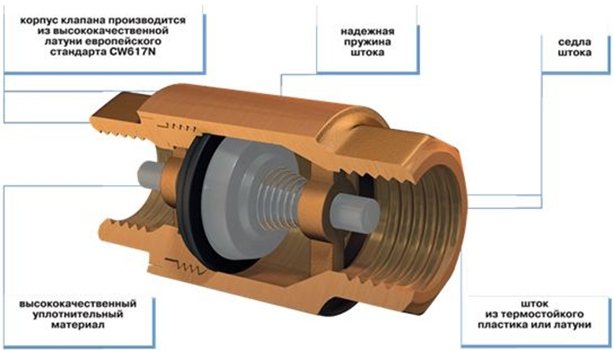
Check valve device
The design of any valve is approximately the same:
- body;
- cover or head;
- saddle;
- damper or shutter;
- spindle or stem;
- flywheel or automatic for moving the spindle.
The principle of operation for the general valve family is as follows. When a liquid or gas enters the body from one side, a head on a stem with a stuffing box seal moves the valve, with the help of which the seat hole either opens or closes, stopping the flow of the working medium or changing the angle of its penetration into the device.
Types and classification
Depending on the design of the damper (gate), it is customary to distinguish between two global valve classes:
- in-line damper - the damper is raised or lowered to open or close the seat;
- butterfly valve - works on the principle of a valve, turning clockwise or counterclockwise, thereby opening or closing the valve.
The structure of valves with a linear damper is:
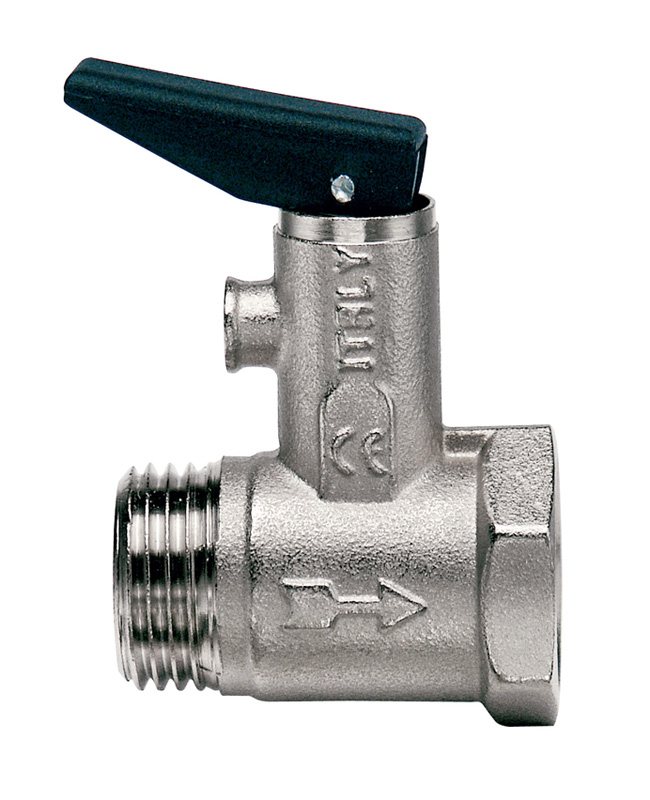

Safety valve for water heater
- shiberny;
- valve;
- needle-like;
- membrane;
- disc-shaped;
- reverse (check valves);
- reducing (pressure reducing valve).
The structure of shut-off equipment with butterfly valves is:
- throttle;
- ball;
- cork;
- regulatory;
- drainage safety;
- drive.
Today we will take a closer look at check valves.

